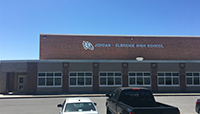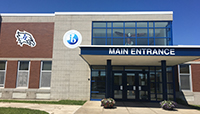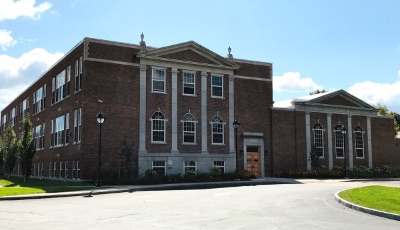7321 - Opioid Overdose Prevention Program
| Policy: Opioid Overdose Prevention Program | Policy Number: 7321 |
| Date of Original Policy: 01/25/2017 | Date Revision Adopted: 07/08/2020 |
| Reviewed by Policy Committee: 06/17/2020 | Date of Next Review: 01/25/2023 |
| Replacement of Policy Number: |
The Board of Education (the “Board”) of the Jordan-Elbridge Central School District (the “District”) has resolved to participate in an existing NYSDOH Registered Opioid Overdose Prevention Program operated by ACR Health (the “Program”), under the direction of the Program’s Clinical Director (the “Clinical Director”).
Required Training for Volunteer School Personnel
As responders under an already existing NYSDOH registered opioid overdose prevention Program, volunteer school personnel are required to complete a NYSDOH approved training Program known as: “Opioid Overdose Training for School Personnel: Recognizing a Life-Threatening Opioid Overdose and Using an Opioid Antagonist.”
After successful completion of this training, an individual will receive a certificate of training in opioid overdose prevention valid for 2 years. The District shall maintain a current list of its trained school personnel. This list will be maintained in the health office or another location designated by the Superintendent.
School Nurses
NYS registered professional nurses (RNs) may administer opioid-related overdose treatment pursuant to a non-patient specific order and protocol prescribed only by a licensed physician or a certified nurse practitioner; they are not able to follow a non-patient specific order written by a physician’s assistance. Accordingly, the Clinical Director issuing the non-patient specific order must be a NYS licensed physician or a certified nurse practitioner. School nurses also can participate in this Program and are able, within the scope of their licensure and authorized practice, to administer either intramuscular (IM) naloxone or IN naloxone pursuant to a non-patient specific order and protocol issued by the Clinical Director.
Maintenance of Opioid Antagonists in the District’s Schools
As a District that is participating under an existing NYSDOH Registered Provider (Option #3), the District may receive naloxone overdose kits for free through the NYSDOH, as prescribed by the Clinical Director.
Legal References:
NY Education Law §§922; 6509-d; 6527; 6909
NY Public Health Law §3309
8 NYCRR §§64.7; 136.8
10 NYCRR §80.138
Guidance for Implementing Opioid Overdose Prevention Measures in Schools:
https://www.schoolhealthny.com/cms/lib/NY01832015/Centricity/Domain/85/OpioidGuidance12_29_16.pdf
ADMINISTRATIVE REGULATIONS, PROTOCOLS & PROCEDURES
For Implementation of Opioid Overdose
Prevention Program Policy No. [Insert]
Clinical Director’s Responsibilities
• Work with the Superintendent of Schools to identify school personnel as potential Trained Overdose Responders (TORs).
• Make the training curriculum, which meets the approval of the NYSDOH, available to District staff designated to be trained;
• Approve and provide ongoing supervision of the trainers;
• Ensure that all TORs successfully complete all components of training program;
• Issue certificates of completion to TORs who have completed the training program;
• Maintain opioid overdose prevention program records including TOR training records, opioid overdose prevention program usage records, and inventories of opioid overdose prevention program supplies and materials;
• Serve as a liaison with local EMS, when appropriate;
• Ensure that the Program’s registration with the NYSDOH remains up-to-date, with no lapse in the Program’s ability to operate;
• Ensure that the NYSDOH is notified in a timely fashion of all changes in the information contained on the Program’s registration form, including names and contact information for the Clinical Director, as well as sites at which the Program operates;
• Provide clinical consultation, expertise and oversight of medical issues related to Program;
• Oversee procurement of naloxone from the NYSDOH and prescribe naloxone kits for the District at no cost;
• Assure that any distribution of opioid antagonists through the District’s Opioid Overdose Prevention Program shall include an informational card or sheet with information on the following:
How to recognize symptoms of an overdose; steps to take prior to and after an opioid antagonist is administered, including calling first responders; the number for the toll-free Office of OASAS Hopeline (1-877-846-7369), and how to access the OASAS website – http://www.oasas.ny.gov.
• Promptly report the administration of naloxone in the District’s schools to the NYSDOH as soon as possible after being notified by designated school personnel.
• Order replacement naloxone for the District if there are not adequate stocks of non-deployed naloxone available on site to replace what was used. Even if only one naloxone dose is used, it shall be replaced. New kits shall be ordered three-months prior to the expiration date of existing stock.
• Maintain a record of all TORs, with the name of the TOR and the date trained.
• File all quarterly and annual reports with NYSDOH to track TORs, kits assigned, naloxone administered, and other related matters, as required by law, on behalf of the District.
• Communicate and collaborate on an ongoing basis with the District’s Superintendent of Schools regarding implementation of the Program on behalf of the District.
Storage, Accounting, Inventory & Placement
Naloxone shall be stored in secure locations that are ready and accessible to designated staff members, consistent with the District’s emergency response plan, which shall include immediate transport of an AED to the scene of an emergency.
A naloxone overdose kit may be stored inside the flap of the AED case. Naloxone and the AEDs are both heat and cold sensitive. If placed in an AED cabinet, a plastic breakaway lock shall be placed on the cabinet. The remaining stock of naloxone shall be stored in a locked cabinet in the school’s health office. The drug will be stored in an environment as outlined by the manufacturer’s guidelines.
The expiration date (typically two years from the date of manufacture) shall be recorded at the time each kit is received and monitored so it is appropriate for emergency use. When new naloxone is placed in the locked storage cabinet or AED cabinet, the lot number, date of receipt, expiration date, and location of the naloxone shall be recorded on the log. Designated personnel placing the naloxone in the storage area shall sign the log and shall monitor expiration dates.
On-site inventory and placement of naloxone and accompanying overdose kit supplies (gloves, disposable face shield, alcohol pads and instructions in English and Spanish) shall be accounted for weekly, and counted by personnel designated by the District’s Superintendent of Schools, to determine whether there are any discrepancies between documented inventory and actual inventory and to verify that the solution in the vial is clear and not discolored. Further, both the IN naloxone glass vial and the IM vial have expiration dates. These dates shall be checked during the weekly accounting and inspection.
Accounting for naloxone in AED cabinets shall occur at the same time the check of the AED is performed. This count shall be included and recorded on the AED log. The log shall include the date, time, and signature of the designated personnel performing the count. This log shall be maintained with whatever naloxone has not yet been deployed in the school health office, with the log being maintained for no less than seven (7) years.
The District’s policies and procedures for the disposal of medications shall apply to the disposal of naloxone. Used nasal atomizers and/or syringes shall either be given to EMS personnel upon arrival, or disposed of under District policies and procedures.
The District may, at the Direction of the Clinical Director, use expired IN naloxone for training purposes, provided that caution is exercised to ensure that expired naloxone is not commingled with naloxone deployed for rescue purposes. If expired IN naloxone is used for training purposes, it shall be labeling the expired naloxone box with a permanent marker in large lettering: TRAINER--DOES NOT CONTAIN MEDICATION; filling the glass vial with colored water, and keeping the training units separate from the IN naloxone which contains medication.
Notifications
When someone is experiencing opioid overdose, they need immediate medical attention and emergency response intervention. Call 911; activate your school’s emergency response system (which must include obtaining the AED), and follow emergency response protocol (CPR/Rescue Breaths/AED).
Administer naloxone and follow school emergency response by calling or asking someone else to call 911. State the person is not breathing.
Parent/guardians and administration must be notified as soon as practicable about naloxone administered to a student along with planned transport to the emergency room. Such notification should also be documented in the student’s cumulative health record. Notification of staff member’s emergency contact(s) should be done as per district policy.
Documentation and Reporting
All administration of naloxone/overdose reversals shall be recorded on forms supplied by the NYSDOH and reviewed as soon as practicable by the Clinical Director, who shall report to the NYSDOH as soon as possible.
Further, any administration of naloxone requires appropriate follow-up documentation. The administration of naloxone shall be documented in the individual’s cumulative health record for students, or consistent with applicable policies for care administered to school staff. Documentation shall be signed by the person completing the documentation and shall include: 1) the date and time and route of administration noting the anatomical location if IM was administered; 2) the signs and symptoms displayed by the student or staff member prior to administration; 3) the student or staff member’s response to naloxone administration, if CPR/rescue breathing/AED was administered; and 4) the name of the EMS agency providing transport, along with the name of the health care facility to which the student/staff person was transported.




